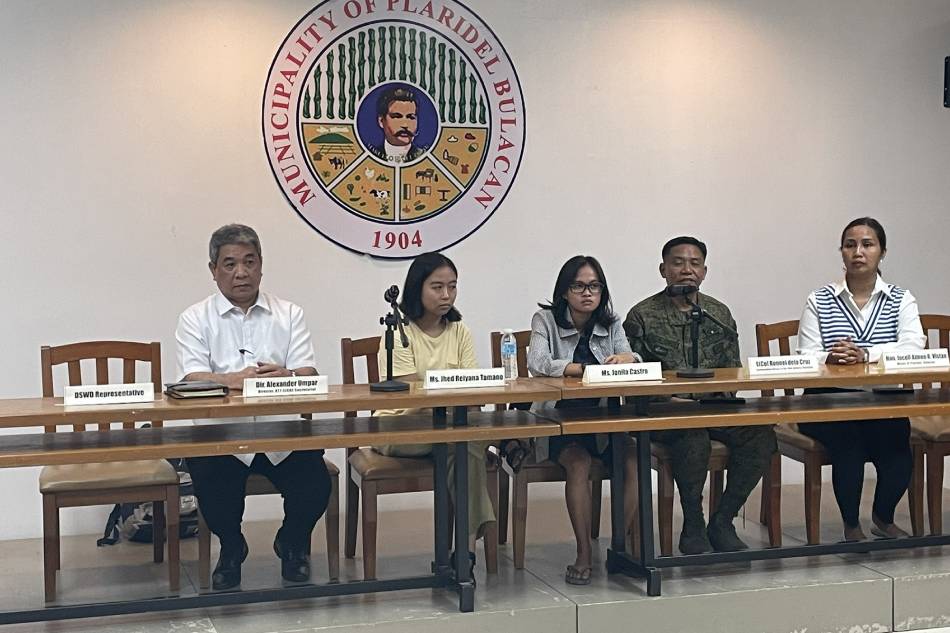Activists' recantation part of CPP-NPA 'new playbook': DOJ
ADVERTISEMENT

Welcome, Kapamilya! We use cookies to improve your browsing experience. Continuing to use this site means you agree to our use of cookies. Tell me more!
Activists' recantation part of CPP-NPA 'new playbook': DOJ
ABS-CBN News
Published Sep 20, 2023 05:43 PM PHT
|
Updated Sep 20, 2023 11:54 PM PHT
MANILA (UPDATED) -- Justice Secretary Jesus Crispin "Boying" Remulla on Wednesday accused two activists of following a "new playbook" of communist rebels, supposedly in a bid to gain public sympathy.
MANILA (UPDATED) -- Justice Secretary Jesus Crispin "Boying" Remulla on Wednesday accused two activists of following a "new playbook" of communist rebels, supposedly in a bid to gain public sympathy.
Environmentalists Jhed Reiyana Tamano and Jonila Castro claimed in Tuesday morning's press conference organized by the National Task Force to End Local Communist Armed Conflict that they were abducted and threatened by soldiers, contrary to reports that they voluntarily surrendered.
Environmentalists Jhed Reiyana Tamano and Jonila Castro claimed in Tuesday morning's press conference organized by the National Task Force to End Local Communist Armed Conflict that they were abducted and threatened by soldiers, contrary to reports that they voluntarily surrendered.
Tamano, a coordinator of the Ecumenical Bishops Forum, said that she and Castro were walking on the road on September 2 when they were grabbed.
Tamano, a coordinator of the Ecumenical Bishops Forum, said that she and Castro were walking on the road on September 2 when they were grabbed.
The 2 also accused government officials of forcing them to sign affidavits supposedly saying they were leaving the communist movement.
The 2 also accused government officials of forcing them to sign affidavits supposedly saying they were leaving the communist movement.
ADVERTISEMENT
Remulla, however, said they have proof that the two activists gave voluntary, handwritten statements and noted that the affidavits were signed in the presence of Tamano and Castro's parents.
Remulla, however, said they have proof that the two activists gave voluntary, handwritten statements and noted that the affidavits were signed in the presence of Tamano and Castro's parents.
"It looks like a new playbook of the CPP-NPA para i-discredit ang gobyerno. Pero I don't think na we should bite into this bait na kanilang sinet up para magmukhang masama ang ating gobyerno," the justice chief said.
"It looks like a new playbook of the CPP-NPA para i-discredit ang gobyerno. Pero I don't think na we should bite into this bait na kanilang sinet up para magmukhang masama ang ating gobyerno," the justice chief said.
The activists' subsequent statement that they were kidnapped and threatened by the military is part of a "choreography", he said.
The activists' subsequent statement that they were kidnapped and threatened by the military is part of a "choreography", he said.
"Nakikita natin talaga, meron talagang choreography na ginaganap para ma-involve ang international community dito. So, very elaborate 'to," he said.
"Nakikita natin talaga, meron talagang choreography na ginaganap para ma-involve ang international community dito. So, very elaborate 'to," he said.
"Maganda ang kanilang choreography, kaya lang we will not give in to this kind of blackmail."
"Maganda ang kanilang choreography, kaya lang we will not give in to this kind of blackmail."
ADVERTISEMENT
"Blackmail 'to na wala talagang lugar sa isang sibilisadong bansa katulad natin," he added.
"Blackmail 'to na wala talagang lugar sa isang sibilisadong bansa katulad natin," he added.
Remulla said the Department of Justice will follow the proper process and conduct an investigation into the incident once a complaint has been filed, either by the military or by the activists.
Remulla said the Department of Justice will follow the proper process and conduct an investigation into the incident once a complaint has been filed, either by the military or by the activists.
The Kabataan Partylist, Gabriela, and ACT Teacher's Partylist have filed a resolution urging the House Committee on Human Rights to conduct an investigation while alleging that the Armed Forces of the Philippines, the Philippine National Police, and NTF-ELCAC "blatantly lied to the public."
The Kabataan Partylist, Gabriela, and ACT Teacher's Partylist have filed a resolution urging the House Committee on Human Rights to conduct an investigation while alleging that the Armed Forces of the Philippines, the Philippine National Police, and NTF-ELCAC "blatantly lied to the public."
PAO IN HOTSEAT
The Public Attorney's Office, meanwhile, is in the hotseat after the recantation of the 2 activists.
The Public Attorney's Office, meanwhile, is in the hotseat after the recantation of the 2 activists.
In an interview, PAO chief Persida Acosta insisted the 2 activists wrote their affidavits in longhand even before a PAO lawyer from Norzagaray interviewed them.
In an interview, PAO chief Persida Acosta insisted the 2 activists wrote their affidavits in longhand even before a PAO lawyer from Norzagaray interviewed them.
ADVERTISEMENT
"Eh may sulat kamay sila, paanong tatakutin ng PAO? Inabutan lang sila.
Nagiging style bulok na ng ibang nag-a-affidavit na pag-gustong mag-recant ay ituturo si PAO, kawawa naman 'yung mga PAO natin," she said.
"Eh may sulat kamay sila, paanong tatakutin ng PAO? Inabutan lang sila.
Nagiging style bulok na ng ibang nag-a-affidavit na pag-gustong mag-recant ay ituturo si PAO, kawawa naman 'yung mga PAO natin," she said.
She said the PAO lawyer interviewed the 2 in a closed-door meeting to verify the contents of their affidavits.
She said the PAO lawyer interviewed the 2 in a closed-door meeting to verify the contents of their affidavits.
"Tiniyak ng PAO na 'yung laman nitong sulay kamay ay 'yung nasa puso nila. Nag-interview siya, ipinaulit-ulit niya yung mga sinasabi ng dalawa.
Ang pakiramdam namin, itong dalawang ito ay may kinakatakutan na may gumanti sa kanila kaya nag-recant," she added.
"Tiniyak ng PAO na 'yung laman nitong sulay kamay ay 'yung nasa puso nila. Nag-interview siya, ipinaulit-ulit niya yung mga sinasabi ng dalawa.
Ang pakiramdam namin, itong dalawang ito ay may kinakatakutan na may gumanti sa kanila kaya nag-recant," she added.
She noted that since 2001, a total of 3,733 former members of the CPP-NPA-NDF including their immediate family members have been reintegrated into society through Task Force Balik-Loob.
She noted that since 2001, a total of 3,733 former members of the CPP-NPA-NDF including their immediate family members have been reintegrated into society through Task Force Balik-Loob.
"Buhay pa silang lahat. 'Yung PAO naka-tie up sa Task Force Balik-Loob ng gobyerno," she said.
"Buhay pa silang lahat. 'Yung PAO naka-tie up sa Task Force Balik-Loob ng gobyerno," she said.
ADVERTISEMENT
ADVERTISEMENT



